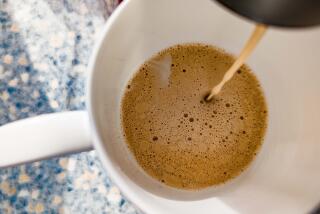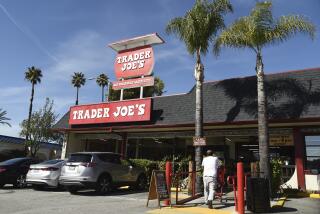Consumers Face Hike in Coffee Prices : Commodities: Folgers is first to implement the markups. Others say theyâll follow suit in wake of Brazilian crop damage.
NEW YORK â The damaging frost in Brazilâs coffee-growing regions is sending shivers thousands of miles away, as consumers face immediate increases in the price of packaged coffee and beans.
Coffee prices on commodity exchanges rose to 7 1/2-year highs Monday and Tuesday following reports of crop-damaging frost in Brazil, the worldâs largest coffee producer.
While the beans affected wonât reach breakfast tables for a year or more, food companies were quick to raise prices on coffee that has already been ordered and packaged and, in many cases, is sitting on grocersâ shelves.
Procter & Gamble Co. was the first to raise prices, saying late Monday that it was increasing the price of its popular Folgers brand by 17%. It could pass along further hikes if the price of green, unroasted coffee continues to soar.
âWe are responding to the sharp increase by raising the price of Folgers by 40 cents per 13 ounces,â Procter & Gamble spokeswoman Wendy Jacques said. Folgers is sold in 13-, 26- and 39-ounce cans. The increase takes effect immediately, Jacques said.
âObviously, along with everyone, weâll be watching the market closely to see if any further adjustments are needed,â she said.
Nestle Beverage Co., which markets Hills Bros., Tasterâs Choice and Nescafe brands, and the A&P; Coffee division of Great Atlantic & Pacific Tea Co., which markets the 8 OâClock Coffee brand, said Tuesday that they will both raise their prices within days.
Nan Redmond, spokesperson for Kraft General Foodsâ Maxwell House Coffee, said the company is âstudying the situation. We are discussing it right now, but we have no announcement.â
Nestle, Maxwell House and Procter & Gamble hold about 70% of the retail coffee market, according to trade and industry sources.
The coffee companiesâ moves follow an astronomical rise in coffee futures to more than $1.73 a pound, compared to 86 cents a pound in late April.
A deep frost Sunday and Monday settled over vast sections of coffee-growing regions in Brazil, jeopardizing between 15% and 30% of next yearâs crop.
Brazil produces 25% to 30% of the worldâs coffee, so even a 15% loss in Brazilian output would translate into a 5% loss in global output, said Accu-Weather, the international weather forecasters.
On Tuesday, spot July coffee contracts closed up 10.55 cents to $1.70 a pound on the New York Coffee, Sugar and Cocoa Exchange. On Monday, July coffee futures jumped 33.8 cents to $1.59 a pound after peaking earlier at $1.80, the highest since November, 1986.
Mondayâs spike was just the latest in a series of market factors that have combined to produce the highest prices for unroasted coffee since the fall of 1986.
Depressed prices in the mid-1980s turned coffee growers away from their crops in search of higher profits, and the scarcity of beans is now surfacing. In an effort to prop up prices, member nations of the Assn. of Coffee Producing Countries in October introduced a plan to retain a percentage of exports and thereby drain reserves in consumer countries.
The plan worked, and prices have climbed steadily since the end of 1993.
More to Read
Inside the business of entertainment
The Wide Shot brings you news, analysis and insights on everything from streaming wars to production â and what it all means for the future.
You may occasionally receive promotional content from the Los Angeles Times.










